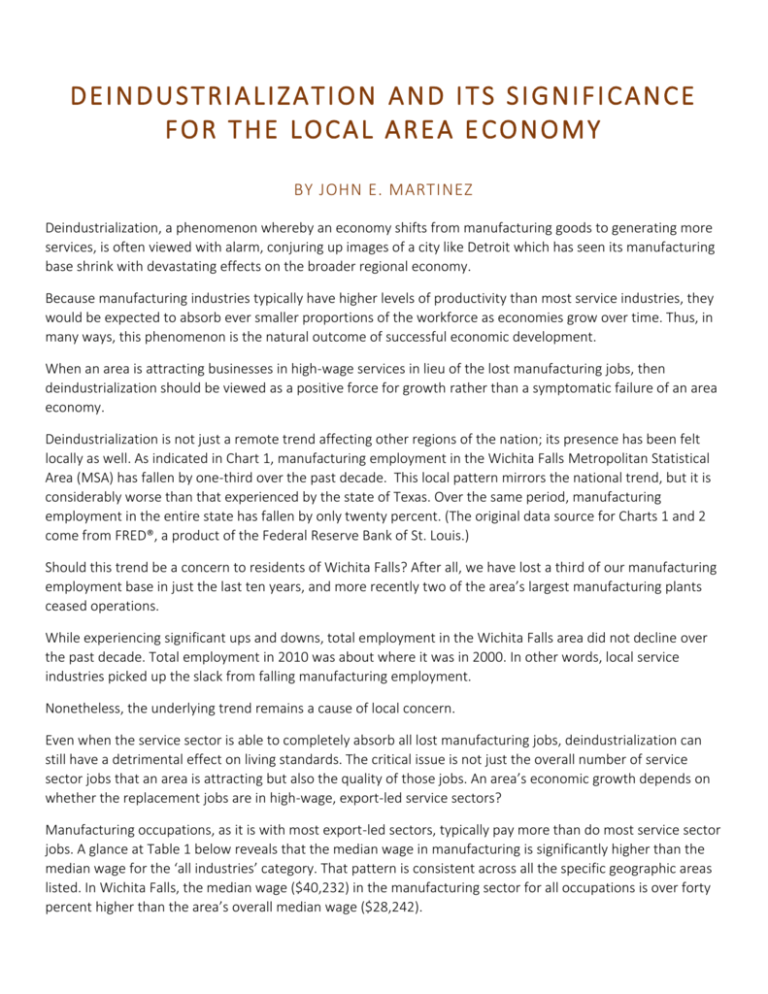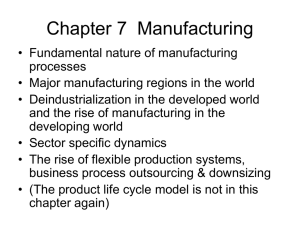Deindustrialization, a phenomenon whereby an economy shifts from
advertisement

D E I N D U S T R I A L I Z A T I ON A N D I T S S I G N I F I C AN C E F O R T H E LO C A L A R E A E C O NO MY BY JOHN E. MARTINEZ Deindustrialization, a phenomenon whereby an economy shifts from manufacturing goods to generating more services, is often viewed with alarm, conjuring up images of a city like Detroit which has seen its manufacturing base shrink with devastating effects on the broader regional economy. Because manufacturing industries typically have higher levels of productivity than most service industries, they would be expected to absorb ever smaller proportions of the workforce as economies grow over time. Thus, in many ways, this phenomenon is the natural outcome of successful economic development. When an area is attracting businesses in high-wage services in lieu of the lost manufacturing jobs, then deindustrialization should be viewed as a positive force for growth rather than a symptomatic failure of an area economy. Deindustrialization is not just a remote trend affecting other regions of the nation; its presence has been felt locally as well. As indicated in Chart 1, manufacturing employment in the Wichita Falls Metropolitan Statistical Area (MSA) has fallen by one-third over the past decade. This local pattern mirrors the national trend, but it is considerably worse than that experienced by the state of Texas. Over the same period, manufacturing employment in the entire state has fallen by only twenty percent. (The original data source for Charts 1 and 2 come from FRED®, a product of the Federal Reserve Bank of St. Louis.) Should this trend be a concern to residents of Wichita Falls? After all, we have lost a third of our manufacturing employment base in just the last ten years, and more recently two of the area’s largest manufacturing plants ceased operations. While experiencing significant ups and downs, total employment in the Wichita Falls area did not decline over the past decade. Total employment in 2010 was about where it was in 2000. In other words, local service industries picked up the slack from falling manufacturing employment. Nonetheless, the underlying trend remains a cause of local concern. Even when the service sector is able to completely absorb all lost manufacturing jobs, deindustrialization can still have a detrimental effect on living standards. The critical issue is not just the overall number of service sector jobs that an area is attracting but also the quality of those jobs. An area’s economic growth depends on whether the replacement jobs are in high-wage, export-led service sectors? Manufacturing occupations, as it is with most export-led sectors, typically pay more than do most service sector jobs. A glance at Table 1 below reveals that the median wage in manufacturing is significantly higher than the median wage for the ‘all industries’ category. That pattern is consistent across all the specific geographic areas listed. In Wichita Falls, the median wage ($40,232) in the manufacturing sector for all occupations is over forty percent higher than the area’s overall median wage ($28,242). Naturally, service sector jobs can be well-paying jobs as well. The kinds of financial services one finds on Wall Street or the entertainment services found on the Las Vegas strip are prime examples of this type. As indicated in Table 1, the information or telecommunications industry is also a case in point with wages typically above area averages. However, we should note that there is wide variation in wages across the various occupations within a specific industry like information services. In a city like Austin the median wage in the ‘information industry’ is approximately fifty percent higher than the ‘all industries’ median wage. The same pattern exists for the entire state. In Wichita Falls, it is only about twenty five percent higher, meaning that our telecommunications industry has a larger share of lower wage occupations than is the case for a high-tech area such as Austin, Texas. In the case of Wichita Falls, our income base has suffered because employment growth in high-wage service industries has not been sufficient to offset the loss of high-paying manufacturing jobs. Employment growth in high-wage industries (which includes Financial, Information, and Professional and Business Services industries) has been flat for Wichita Falls over the past decade. By contrast, the Austin metro area has seen a twenty percent gain in high-wage service industry jobs. Local civic leaders, mainly through the leadership of the Chamber of Commerce and Industry, have been tremendously successful over the past several years in attracting new industry to the area. During the past year alone, Wichita Falls has completed almost a dozen projects that will result in the retention, expansion, and attraction of over 2,000 primary jobs and conservatively another 1,000 secondary jobs over the next three years. The fact that total employment over the past ten years has not decreased in face of such draconian losses to our manufacturing base is testament to that fact. Despite all those phenomenal efforts, we haven’t yet been able to replace our manufacturing losses with equally paying service sector jobs. On a realistic note, attracting those kinds of jobs to the area will require more than an excellent marketing effort; it will require long-term vision and commitment. As a regional economy, the north Texas area is blessed with abundant energy resources and a strong entrepreneurial spirit to match. At the same time, we need a plan of diversification; the oil and gas industry can’t be relied upon as a stable source of growth in the years ahead What specific comparative advantage is present for attracting high-wage service industry jobs to the area? We have a highly favorable business climate and an exceptionally good work ethic, but so do other cities in Texas. We have a very effective and proactive Chamber; but, without any specific geographic advantage, attracting high-tech, export-led service businesses to the area will be especially difficult. Irrespective of whatever strategies we ultimately pursue, one thing is clear. Continued deindustrialization has important implications for the long-term growth prospects for the area’s economy. Most obviously, as more of the workforce inevitably moves into the service sector, our ability to attract high-wage, export-driven service sector jobs will probably determine the outlook for local living standards. Edited by Wendy Coker








